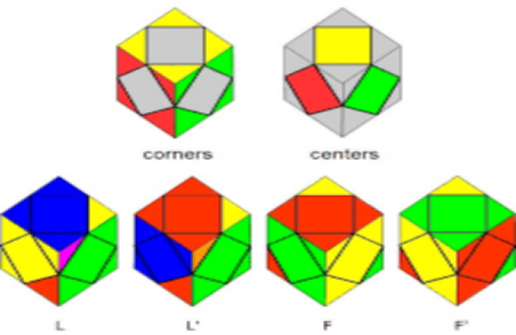Introduction
The Skewb Cube is a unique twist on the classic Rubik’s Cube. While it shares the basic idea of color-matching puzzle-solving, the Skewb has its own special mechanism. It features a cube with cuts through its center, aligned orthogonally to the main diagonals, allowing for rotation of its half-cubes. Turning the half-cubes by 120° or 240° creates different color patterns while keeping the structure intact.
At first glance, solving the Skewb might seem complex. However, with the right algorithms and methods, it can be easily solved. In this guide, we’ll go over some user-friendly steps and strategies to help you solve the Skewb Cube.
Skewb Notations

Before diving into solving the Skewb, let’s familiarize ourselves with some essential notations:
Front corner (F) – the corner facing you
Right corner (R) – the corner to your right
Left corner (L) – the corner to your left
Back corner (B) – the corner opposite to you
Up corner (U) – the corner on top of the cube
Method 1: A Beginner-Friendly Approach
Step 1: Solve the First Layer
Begin with solving the white face. The goal here is to position the white center piece on the top layer, while also placing the corresponding white corner pieces in the correct spots.
Tip 1: If the white corner piece is on the right and facing you, simply twist it into the upper layer.
Tip 2: If it’s on the left, twist it to the left upper side. If it’s at the bottom, rotate the cube to bring it to the top layer.
Step 2: Solve the Centerpieces
Once the white face is completed, it’s time to solve the other centerpieces of the cube. Hold the Skewb with the solved white face on the bottom and focus on matching the top centerpiece with the surrounding corner pieces.
To swap the front and top centerpieces, use this algorithm:
R’ L R L’
Rotate the right corner counterclockwise.
Rotate the left corner clockwise.
Rotate the right corner clockwise.
Rotate the left corner counterclockwise.
Repeat this algorithm until all the centerpieces are in place, with the yellow centerpiece eventually appearing at the top.
Step 3: Solve the Last Layer
With the yellow centerpiece on top, you will encounter two possibilities:
Case 1: If there are already two yellow corners on the top layer, you can easily complete the last layer with the algorithm:
(R’ L R L’) x 2
Case 2: If no yellow corners are on the top, perform the algorithm twice to rotate the four yellow corners into their correct positions.
Method 2: An Alternative Approach Using Rubik’s Cube Notations
In this method, we apply the classic Rubik’s Cube face notations to the Skewb, but instead of focusing on the faces, we work with the corners.
Step 1: Solve the First Face
Start by experimenting and matching the corner pieces around the center piece of the same color. Once three corners are solved and the fourth one is misaligned, use one of these algorithms to rotate the top corners:
Algorithm 1:
F R F’ R’
Rotate the front corner clockwise.
Rotate the right corner clockwise.
Rotate the front corner counterclockwise.
Rotate the right corner counterclockwise.
Algorithm 2:
F’ L’ F L
Rotate the front corner counterclockwise.
Rotate the left corner counterclockwise.
Rotate the front corner clockwise.
Rotate the left corner clockwise.
After using one of these algorithms, you should have a completed first face.
Step 2: Solve the Centerpieces
With the first face completed, align the remaining centerpieces. Hold the solved face upwards and rotate the corner pieces until all centers are correctly aligned.
Algorithm 1:
L B L’ B’
Rotate the left corner clockwise.
Rotate the back corner clockwise.
Rotate the left corner counterclockwise.
Rotate the back corner counterclockwise.
Algorithm 2:
R’ B’ R B
Rotate the right corner counterclockwise.
Rotate the back corner counterclockwise.
Rotate the right corner clockwise.
Rotate the back corner clockwise.
Step 3: Solve the Remaining Corners
Now, use another algorithm to solve the remaining four corners. Keep the solved face at the top and perform the following until the cube is fully solved:
L’ F L F’
Rotate the left corner counterclockwise.
Rotate the front corner clockwise.
Rotate the left corner clockwise.
Rotate the front corner counterclockwise.
Conclusion
Solving the Skewb is not as hard as it might seem at first. With just a few algorithms and some practice, you’ll be able to solve it confidently. Remember that there are multiple approaches to solving the Skewb, so don’t be afraid to try different methods based on how the puzzle is scrambled. Keep practicing, and enjoy the process of cubing!
Happy solving!
